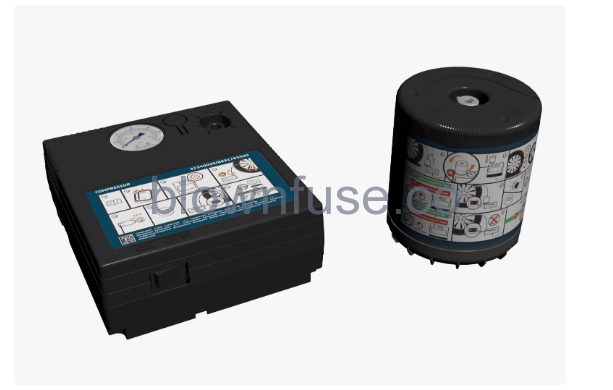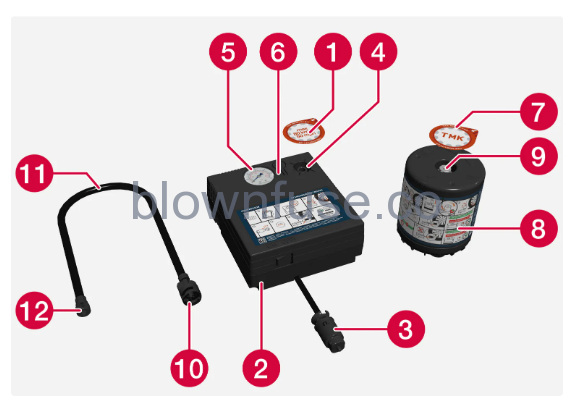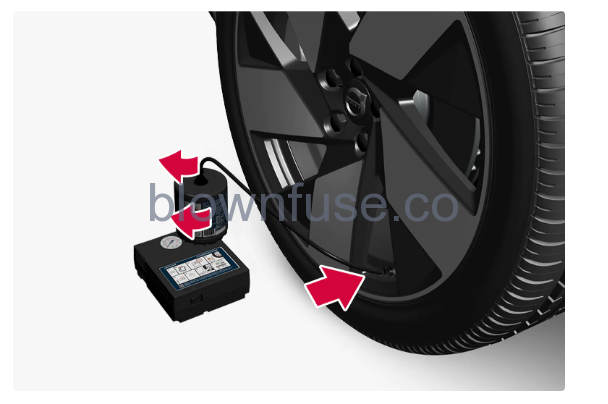2023 Volvo XC40 Recharge Pure Electric Emergency puncture repair

Emergency puncture repair kit
The emergency puncture repair kit (TMK) is used to seal a puncture as well as to check and adjust the air pressure in the tyre.
Cars equipped with spare tyre do not have the emergency puncture repair kit.
The puncture repair kit consists of a compressor and a bottle with sealing fluid. The sealing works as a temporary repair.

Inflating tyres with the compressor from the puncture repair kit
The car’s original tyres can be inflated using the compressor in the emergency puncture repair kit.
The compressor must be switched off. Make sure that the switch is in position 0 (Off), and take out the electrical cable and the air hose.
Attach the air hose directly into the compressor’s bottle bracket and then turn clockwise 90 degrees.
Move the warning decal to the side of the compressor. It does not need to be attached to the wheel cover unless the sealing fluid is used.
Unscrew the tyre’s dust cap and screw in the air hose’s valve connection to the bottom of the thread on the tyre’s air valve.
Connect the electrical cable to the closest 12 V socket and start the car.
- Do not leave children in the car without supervision when the car is running.
- Start the compressor by flicking the switch to position I (On).
- Risk of overheating. The compressor must not run for more than 10 minutes.
- Inflate the tyre to the pressure specified on the tyre pressure label on the driver-side door pillar. Release air using the pressure-reducing valve if the tyre pressure is too high.
- Switch off the compressor. Detach the air hose and the electrical cable.
- Refit the dust cap on the tyre.
- If necessary, save a new tyre pressure in the system for tyre pressure monitoring.
- After a tyre has been inflated, always refit the dust cap in order to avoid damage to the valve from gravel, dirt, etc.
- Only use plastic dust caps. Metal dust caps can rust and become difficult to unscrew.
Using a puncture repair kit
The emergency puncture repair kit (TMK) can be used to seal a puncture. Read through all instructions before use.
Overview

- Label, maximum permitted speed
- Switch
- Electrical cable
- Bottle bracket
- Pressure gauge
- Pressure reducing valve
- Decal, warning for wheel cover
- Sealing fluid bottle
- Bottle opening
- Connection for bottle
- Air hose
- Connection valve
Connecting

Please keep the following points in mind when using the tyre sealing system:
- The sealing fluid bottle contains natural rubber latex. This substance is harmful if swallowed.
- The contents of this bottle may cause allergic skin reactions or otherwise be potentially harmful to the respiratory tract, the skin, the central nervous system, and the eyes.
Precautions:
- Store out of the reach of children.
- Harmful if ingested.
- Avoid prolonged or repeated contact with the skin. If sealing fluid has come into contact with your clothes, remove them.
- Wash thoroughly after handling.
First aid:
- Skin: Wash affected areas of skin with soap and water. Get medical attention if symptoms occur.
- Eyes: Flush with plenty of water for at least 15 minutes, occasionally lifting the upper and lower eyelids. Get medical attention if symptoms occur.
- Inhalation: Move the exposed person to fresh air. If irritation persists, get medical attention.
- Ingestion: Get medical attention.
- Disposal: Dispose of this material and its container at a hazardous or special waste collection point. Always follow state and local environmental regulations.
Preparations
Set up the warning triangle and activate the hazard warning lights if a tyre is being sealed in a trafficked location.
Detach the decal for the maximum permitted speed that is affixed on one side of the compressor. Affix it visibly on the windscreen as a reminder to observe the speed limit. You should not drive faster than 80 km/h (50 mph) after the emergency tyre repair kit has been used.
In addition, remove the warning decal and attach it firmly to the side of the wheel so that it doesn’t fall off.
Check that the switch is in position 0 (Off) and locate the electrical cable and the air hose.
Fit the sealing fluid bottle in the compressor and then turn clockwise 90 degrees.
The bottle is equipped with a non-return valve which means that the fluid does not come out unless it is fitted in the compressor.
Attach the air hose to the bottle’s opening and turn clockwise 90 degrees.
Unscrew the tyre’s dust cap and screw in the air hose’s valve connection to the bottom of the thread on the tyre’s air valve.
Begin puncture repair
Connect the electrical cable to the closest 12 V socket and start the car.
- Do not leave children in the car without supervision when the car is running.
- Start the compressor by flicking the switch to position I (On).
- When the compressor starts, the pressure can increase up to 7 bar (102 psi), but the pressure drops after about 30 seconds.
- Never stand next to the tyre when the compressor is running. If cracks or unevenness arise then the compressor must be switched off immediately. The journey should not be continued. Call roadside assistance for recovery to a tyre centre. Volvo recommends an authorized tyre centre.
- Inflate the tyre for 7 minutes.
Switch off the compressor to check the pressure on the pressure gauge. The minimum pressure is 1.8 bar (26 psi) and the maximum is 2.5 bar (36 psi). Release air using the pressure-reducing valve if the tyre pressure is too
high.
To access the pressure-reducing valve, the sealing fluid bottle must first be removed. Remove the bottle in the following order:
- Remove the air hose from the tyre valve.
- Remove the air hose from the bottle.
- Remove the bottle from the compressor.
- Refit the air hose directly in the compressor.
- Refit the air hose to the tyre valve.
- Release air by pressing the pressure-reducing valve.
- If the pressure is below 1.8 bar (26 psi) then the hole in the tyre is too big. The journey should not be continued. Call roadside assistance for recovery to a tyre centre. Volvo recommends an authorized tyre centre.
- Switch off the compressor and detach the electrical cable.
- Unscrew the air hose from the tyre valve and refit the dust cap on the tyre.
- After a tyre has been inflated, always refit the dust cap in order to avoid damage to the valve from gravel, dirt, etc.
- Only use plastic dust caps. Metal dust caps can rust and become difficult to unscrew.
Clean the air hose before putting it away and be careful that there is no leakage of sealing fluid.
As soon as possible, drive at least 3 km (2 miles) at a maximum speed of 80 km/h (50 mph) so that the sealing fluid can seal the tyre, and then perform a follow-up check.
Follow-up inspection
Connect the air hose on the tyre valve and screw in the valve connection to the bottom of the tyre valve’s thread. The compressor must be switched off.
Read the tyre pressure on the pressure gauge.
- If it is below 1.3 bar (19 psi) then the tyre is insufficiently sealed. The journey should not be continued. Call roadside assistance for recovery.
- If the tyre pressure is higher than 1.3 bar (19 psi), the tyre must be inflated to the pressure specified in accordance with the tyre pressure label on the driver’s side door pillar (1 bar = 100 kPa = 14.5 psi). Release air using the pressure-reducing valve if the tyre pressure is too high.
- Check the tyre pressure regularly.
- Volvo recommends that the car is driven to the nearest authorized Volvo workshop for the replacement/repair of the damaged tyre. Advise the workshop that the tyre contains sealing fluid.
- The sealing fluid bottle and hose must be replaced after use. Volvo recommends that these replacements be performed by an authorized Volvo workshop.

